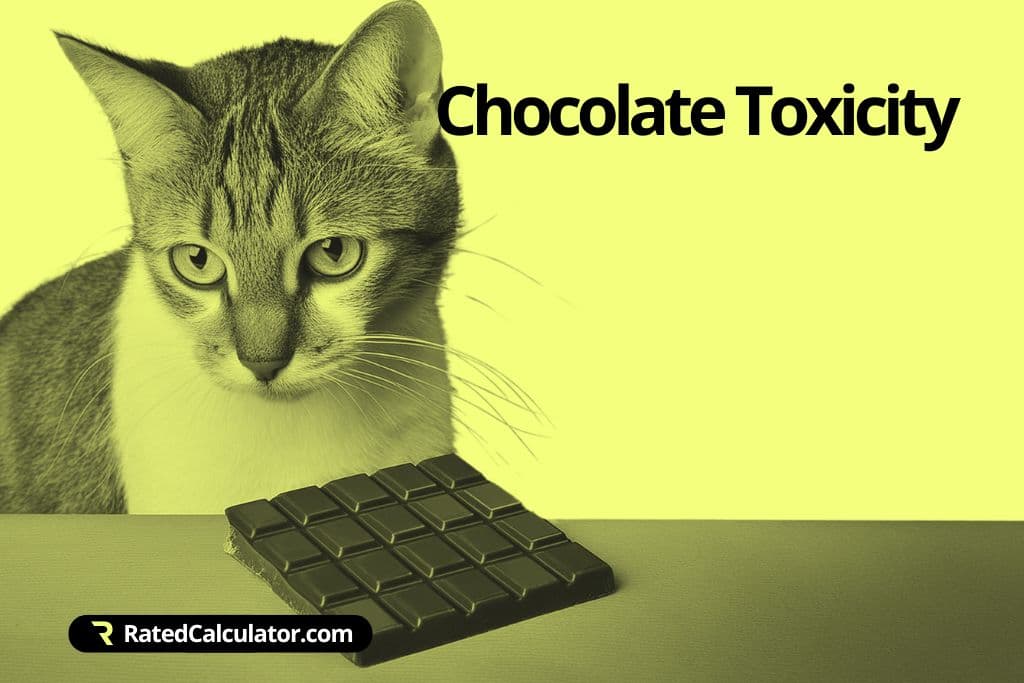Cat Chocolate Toxicity Calculator
None
Methylxanthines dose: 5.31 mg/kg = 0.0000850000 oz/lb
- None
- Mild
- Moderate
- Severe
*Toxicity can be affected by breed, age, and other factors.
What is the Cat Chocolate Toxicity Calculator?
The Cat Chocolate Toxicity Calculator helps cat owners assess the potential danger of chocolate ingestion. Chocolate contains methylxanthines (theobromine and caffeine) that are harmful to cats. This calculator estimates the risk based on chocolate type, amount eaten, and cat's weight.
How to Use the Cat Chocolate Toxicity Calculator

Start by entering your cat's weight (kg or lb). Then input the amount of chocolate consumed (g or oz), and select the type of chocolate. The calculator will determine the toxicity level and potential health risks based on your cat's weight and the chocolate ingested.
Expected Symptoms at Different Toxicity Levels
This table outlines the expected symptoms in cats at different levels of chocolate toxicity.
| Toxicity Level | Methylxanthines Dose (mg/kg) | Expected Symptoms |
|---|---|---|
| None | 0-15 | No symptoms expected. Safe zone. |
| Mild | 15-30 | Vomiting, diarrhea, restlessness, increased heart rate. |
| Moderate | 30-45 | Hyperactivity, tremors, elevated heart rate, mild seizures. |
| Severe | 45-75+ | Severe seizures, high heart rate, muscle tremors, potentially fatal. |
Why is Chocolate Toxic for Cats?
Chocolate contains theobromine and caffeine, toxic to cats. Cats metabolize these substances much more slowly than humans, making them more susceptible to their toxic effects. Even small amounts can cause significant health issues.
Symptoms include vomiting, diarrhea, rapid breathing, increased heart rate, and in severe cases, seizures and death. Dark chocolate and cocoa powder contain the highest concentrations of theobromine.
Other foods that can be toxic to cats include:
- Caffeine: Found in coffee, tea, and some sodas.
- Grapes and Raisins: Can cause kidney failure in cats, though the exact toxic substance is unknown.
It’s essential to prevent cats from consuming these foods and seek veterinary care immediately if ingestion occurs.
How Much Chocolate is Toxic to Cats?
The toxic dose of chocolate for cats depends on the type of chocolate, the amount consumed, and the cat's weight. Here are some general guidelines:
- Milk Chocolate: Toxic dose is approximately 0.5 ounces (15 grams) per pound of body weight.
- Dark Chocolate: Toxic dose is approximately 0.1 ounces (3 grams) per pound of body weight.
- White Chocolate: Contains very little theobromine and is less likely to cause toxicity, but it can still cause issues due to its fat and sugar content.
Chocolate Toxicity Thresholds for Cats (Severe Toxicity)
| Cat Weight (lbs) | Cat Weight (kg) | Milk Chocolate (g) | Milk Chocolate (oz) | Dark Chocolate (g) | Dark Chocolate (oz) |
|---|---|---|---|---|---|
| 2 lb | 0.91 kg | 9.10 g | 0.32 oz | 1.36 g | 0.05 oz |
| 4 lb | 1.81 kg | 18.20 g | 0.64 oz | 2.73 g | 0.10 oz |
| 6 lb | 2.72 kg | 27.30 g | 0.96 oz | 4.09 g | 0.14 oz |
| 8 lb | 3.63 kg | 36.40 g | 1.28 oz | 5.46 g | 0.19 oz |
| 10 lb | 4.54 kg | 45.50 g | 1.60 oz | 6.82 g | 0.24 oz |
| 12 lb | 5.44 kg | 54.60 g | 1.93 oz | 8.19 g | 0.29 oz |
Treating Chocolate Poisoning in Cats
Chocolate poisoning requires prompt action to ensure the health and safety of your cat. If you suspect your cat has ingested chocolate, follow these steps:
Immediate Steps
- Contact Your Veterinarian: Call your vet immediately for advice.
- Induce Vomiting: If instructed by your veterinarian, you may need to induce vomiting to prevent further absorption of toxins.
Veterinary Treatment
- Activated Charcoal: Administered to absorb any remaining toxins in the stomach.
- IV Fluids: Helps maintain hydration and support kidney function.
- Medications: Various medications may be used to control symptoms.
Aftercare and Monitoring
- Follow-Up Appointments: Schedule follow-up visits with your veterinarian.
- Monitor Symptoms: Watch for any recurring or new symptoms.
- Dietary Precautions: Ensure your cat's diet is free from chocolate and other toxic foods.
Other Factors Affecting Chocolate Toxicity in Cats
Several factors can influence the severity of chocolate toxicity in cats:
- Size and Breed: Smaller cats are more susceptible to chocolate toxicity due to their size.
- Health Status: Cats with pre-existing conditions may be more vulnerable to toxic effects.
- Age: Puppies and older cats tend to have weaker immune systems, making them more susceptible.
- Type of Chocolate: Dark chocolate and cocoa powder are more toxic due to higher concentrations of theobromine.
- Frequency of Exposure: Repeated exposure can lead to cumulative toxic effects. Avoid any foods that contain chocolate.